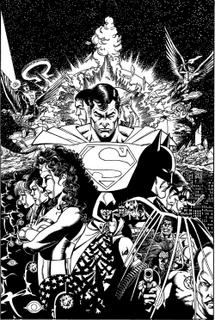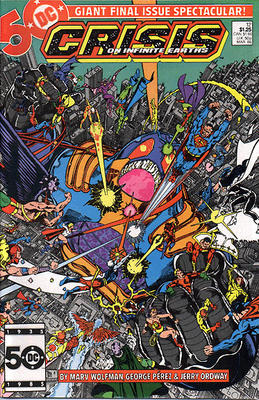
DC Comics is preparing to unleash "Infinite Crisis" on comic shops everywhere. You can get a spoiler-filled synopsis of the events leading up to this huge event here.
Twenty years ago, DC decided to clean house with the 12-issue maxi-series, "Crisis on Infinite Earths." The tagline for it was "Worlds will live. Worlds will die. And the universe will never be the same again."
 When the series debuted, I was 10, and was just really getting to be a die-hard comic book nut. I learned of the series in a promo book they put out, DC Sampler. It was basically a collection of one- and two-page house ads designed to spotlight what was coming up. This particular sampler had cool cover art by the always-cool Fred Hembeck.
When the series debuted, I was 10, and was just really getting to be a die-hard comic book nut. I learned of the series in a promo book they put out, DC Sampler. It was basically a collection of one- and two-page house ads designed to spotlight what was coming up. This particular sampler had cool cover art by the always-cool Fred Hembeck.In the ad, it was called "Universe: Crisis on Infinite Earths." I remember thinking, man, I've got to look for that.
As it is, I picked up Crisis #1 at 7-Eleven as part of a two-pack. I don't know if it was like that at other 7-Elevens, but at mine, most of the comics were bundled in pairs, and they weren't similar titles. I think the other comic in the pack was a Fantastic Four, but I'm not sure.
As this is a 20-year-old comic, I'm not worried about revealing plot points. But just in case, spoilers ahoy...
In only the first few pages, a group of villains called The Crime Syndicate are killed by a rampaging wall of anti-matter. Their Earth, their entire universe are wiped out.
Man oh man, this was good stuff.
For those of you who aren't comic book fans, I'll try to explain this as best I can.
DC Comics used to have a system of sorts that corresponded with their various heroes. Keep in mind they'd been publishing superhero comics for about 50 years by this time and had quite a stable.
Some of the heroes from the Golden Age didn't make it through the 1950s when comic books were accused of promoting juvenile deliquency, among other things. Superman, Batman and Wonder Woman made it through okay, but Flash, Green Lantern, Hawkman and others didn't.
Instead, new heroes with the same names were introduced. Eventually, the Golden Age heroes were revived. Turns out they didn't disappear; they were on a parallel earth. Our Flash, whose secret identity was Barry Allen, met up with Jay Garrick, the original Flash from the 40s. Jay was the Flash on what Barry called Earth-2 for matters of simplicity.
What started as a neat idea in an issue of the Flash snowballed into a huge, sprawling multiverse complete with numerous parallel worlds with duplicate versions of heroes.
Earth-1 was the "main" Earth. That's where current issues of our favorite DC comics were happening.
Earth-2 featured all the World War II-era heroes, including an older Superman, Batman, etc. As they began their careers in the 40s, they were about a generation older than the Earth-1 heroes. As time went on, this gap got a little wider.
Earth-3 was a version of Earth in which there were no superheroes (initially), but a group supervillains -- The Crime Syndicate, who bit the dust in the first few pages of Crisis #1. History was also skewed; actor Abraham Lincoln shot President John Wilkes Booth, and I think England declared independence from America.
There were also Earths X and S, and a whole lot of others.
To add to the potential confusion, there were tons of different stories that featured future events, and they didn't all match. For example, Superman, when he was Superboy, was a member of the Legion of Super-Heroes. The Legion took place in the 30th century.
But then Superman had also met Kamandi, the Last Boy on Earth, who lived on a post-apocalyptic Earth. Was Kamandi from another parallel Earth or was the Legion?
DC said that this was confusing to new readers and was part of the reason behind Crisis.
Now, speaking as someone who was a new reader then (and, keep in mind I was 10, which I believe was their target demographic at the time), I can say that I had no problem keeping up with it.
I actually liked the different Earths, and if I read two stories that contradicted each other, I just kinda picked which one I liked better. If it really got to be a point of contention (if I'd gotten in conversations with friends who also liked comics), I could come up with a way around the problem.
As cool as that first issue was, I didn't pick up another issue until #7. While I went to the comic book store fairly regularly, I still bought the bulk of my comics from Waldenbooks or drugstores.
I was standing at the spinner rack, skimming the comic when I saw what happened near the end: Superman's cousin, Supergirl, died. I was shocked.
(Yes, I know there've been like a jillion Supergirls since then. Don't make me explain it.)
I made a point to get the rest of the series. It was exciting because I didn't know what else was going to happen. Who else was going to die?
 And then in the last issue, it was a huge battle starring just about every DC superhero I'd ever seen, plus a metric buttload of ones I hadn't seen.
And then in the last issue, it was a huge battle starring just about every DC superhero I'd ever seen, plus a metric buttload of ones I hadn't seen.I picked up that last issue during a field trip to the library. During our lunch break, I traipsed down to the comic shop and snagged it with part of what I was supposed to use for lunch. (Sorry, Mom.)
I can still remember sitting downstairs in the children's library to avoid being spotted by my teacher. I read it in only a few minutes, trying to absorb every detail, noting deaths and rebirths.
Crisis remains one of my favorite comic series, and I'm interested in this new Crisis, just to see what's going on. I've read conflicting rumors of what the series is supposed to accomplish, but I'm still a little curious.
With all the crossovers and preludes, it's already a Crisis on a Finite Wallet.

F@&&*^^ reading a book
ReplyDelete